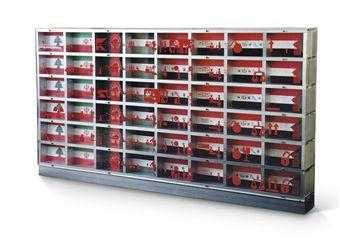About Mahmoud Bakhshi Moakhar
Mahmoud Bakshi was born in Tehran. Bakshi spent part of his high school years at the art school and received a diploma in graphics in 1995. Then he entered the Faculty of Fine Arts in Tehran, studied sculpture, and received his bachelor's degree in 2001. In 2000, he participated in the Tehran Sculpture Second Biennale and won the honorary award for this event. The same year, he held his first solo exhibition in Barg Gallery, Tehran. He also worked as the editor and art director of "Mojassameh" magazine. In 2002, he won the second prize in the Tehran sculpture;'s third biennale. At the same time, he won a scholarship to study at the Paris International Art Village and went to France. At the same year, his works were displayed in the "New Art Exhibition" at the Tehran Museum of Contemporary Art. A year later, his sculptures were presented in a group exhibition at Paris Internationale. Since then, he has had many individual and group exhibitions in different cities arounf the world, including Beijing, Seoul, Frankfurt, London, New Delhi, Berlin, Paris, etc. In 2013, Bakhshi participated as a representative of Iranian art in the 55th Venice Biennial. Among his other important experiences, we can mention the group exhibition "Transformed Visions" at the Tate Modern Gallery, London. Also, after winning the Magic of Persia Award at the Royal College of London, he held an exhibition at the Saatchi Gallery in London. In 2021, his works were presented by Mohsen Gallery at the "Brussels Art" art fair.
Bakshi is a multidisciplinary and experimental artist and has tested his creative ideas in different directions. His works must be categorized and named under a variety of styles. Many of his works oscillate and form on the border between other mediums. For example, a piece titled "Iranian carpet," a small carpet woven with the pattern of the American flag, or "a tulip blown from the blood of the youth of the homeland," which is a combination of an aluminum base, a neon section and an electric motor to pump the liquid inside the tank. Or the "Persian money maker script," which is acrylic and polished on a sack, and a work titled "The Bahman Wall," created by stacking many cigarettes in a metal structure. The common interfacial of most of these works, despite the differences in the materials, execution method, and even the spirit of the medium, is their reliance on concepts. Concepts that mainly have clear political and social implications and are related to hot issues of the day. Along with his revelations, he has also presented his works via performance and video art.
The Most Expensive Artwork
At Auctions
First Attendance
23 November 2008
# Attendance
26
# Artworks
27
Average Realized Price
18,850 USD
Average Min Estimate
12,476 USD
Average Max Estimate
17,128 USD
Sell-through Rate
50%
Average Growth of Artwork Worth
40.246%
Timeline
… And Poetry Will No Longer Serve exhibition
15 November
Online MIDDLE-EAST: Contemporary Arab, Iranian & Turkish Art auction
17 October
The 21st Tehran - Contemporary Iranian Art auction
11 October
Khosrownameh exhibition
12 July
Middle-East/20th Century Art auction
11 July
Auction Due to Job Change exhibition
17 May
How To Be Iranian? (or Not) exhibition
3 November
Contemporary Art auction
16 September
Beirut-Paris Part II - Middle Eastern Art Online Sale auction
24 July
Testimony of a Journey: The Al Zayani Collection auction
25 April
Middle Eastern Modern and Contemporary Part II auction
20 December
A look at the world: Count & Countess Jean-Jacques de Flers Collection auction
21 September
Vanishing Point exhibition
6 May
Solo exhibition Of Mahmoud Bakhshi exhibition
18 February
Rebel, Jester, Mystic, Poet Contemporary Persians—The Mohammed Afkhami Collection exhibition
10 September
now... exhibition
10 September
The 14th Tehran- Contemporary Iranian Art auction
12 August
Matters of Material auction
11 November
Resilience exhibition
31 July
Word By Word exhibition
24 July
Friends & Enemies exhibition
8 July
Shabtab 7 exhibition
14 February
دوازدهمین دوره حراج تهران auction
17 January
Limited Editions exhibition
9 August
Forty - Fifty - Sixty exhibition
21 June
دهمین دوره حراج تهران auction
11 January
The Short Notice/ Bon-Gah exhibition
31 August
Out of Exhaustion exhibition
6 July
Art of the 20th & 21st Century auction
16 February
The Unity of Time and Place exhibition
26 January
The 6th Tehran- Contemporary Iranian Art auction
23 December
Artworks of the Post-War Era auction
18 June
Art of the 20th and 21st Century auction
14 March
China Now! and Asian Contemporary Art auction
4 December
Pop Art auction
30 October
Solo Exhibition exhibition
2 October
Islamic and Indian Art auction
9 June
Solo exhibition of Mahmoud Bakhshi exhibition
19 December
Mahmoud Bakhshi exhibition
14 December
سومین دوره حراج تهران auction
30 May
TalkCloud exhibition
7 February
Modern and Contemporary Arab,Iranian and Turkish Art Part II auction
30 October
دومین دوره حراج تهران auction
28 May
Modern and Contemporary Arab, Iranian and Turkish Art Part II auction
26 October
Bah Man exhibition
8 June
Tulip Rise From The Blood of the Nation's Young exhibition
18 September
Piasa - Paris - November 2008 auction
23 November
